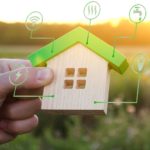Features - Business
Using the Energy Technology List to create cost and energy savings

Installing energy efficiency equipment can deliver substantial cuts in operational costs and carbon emissions. The Energy Technology List (ETL) is as a trusted source of information for selecting energy efficient equipment to deliver these savings.
If the UK economy is to achieve the net zero emissions target by 2050, then it will be vital for organisations to improve efficiency in all sectors, including the construction industry.
The UKGBC estimate that the built environment contributes about 40% of the UK’s total carbon footprint and when looking at electricity use, state that 67% of the total electricity supply in the UK was consumed in buildings in 2016. So there is every reason to design energy efficiency measures in new builds and install energy efficient equipment as part of retrofitting projects.
There is also an opportunity cost from failing to invest in energy efficient technologies sooner rather than later. Securing these cost savings can cut overheads and ultimately improve cash flow, as well as avoiding higher overall energy costs over an extended time period.
Whilst there are a number of different tools and financing options to help investments in high performing products, businesses should always consider using the Energy Technology List (ETL)-.
The ETL is a UK government-managed list of approximately 14,000 of the most energy efficient products across 56 technology categories. It is free-to-use and provides organisations with the confidence that they are buying equipment that demonstrates an objectively high standard of energy efficiency performance. The list is maintained through regular, independent evaluations of the market across the relevant technology categories, providing a benchmark for what currently represents top performance.
For many large businesses within the construction sector, the ETL has become an integral part of the procurement process due to schemes such as BREEAM and SKA. BREEAM is the world’s first sustainability assessment method for buildings, developed by Building Research Establishment (BRE), while SKA rating is an environmental assessment method for non-domestic fit-outs, led by RICS. Businesses seeking to achieve a high rating against SKA or BREEAM criteria can do so by selecting equipment from the ETL. This is because both schemes include ETL-listed energy efficient equipment in their criteria.
Technologies featured on the ETL include: automatic monitoring and targeting (aM&T) equipment; boiler equipment; combined heat and power (CHP); heat pumps; heating, ventilation and air-conditioning (HVAC) equipment; lighting; motors and drives; refrigeration equipment; and waste heat to electricity conversion equipment.
Due to the rigorous energy standards and testing processes, products on the ETL are typically in the top 25%of products available in the market for energy efficiency. By using the list, customers can similarly be confident that they are gaining operational savings compared to less efficient alternatives and significantly reducing the r total cost of ownership.
The Enhanced Capital Allowance (ECA) scheme enables businesses who purchase technologies listed on the ETL to claim accelerated tax relief on their taxable profits. This incentive can help strengthen the business case for investment, making it more appealing for companies that might otherwise be reluctant to spend the large upfront costs on new equipment.
Although the ECA scheme is closing in April 2020, it is important to note that the government has no plans to stop supporting the ETL beyond this point. The ETL can also be paired with other forms of accelerated tax relief, such as the Annual Investment Allowance (AIA). The AIA limit has been raised to £1 million for two years from January 2019, enabling businesses investing in new plant and machinery to be able to claim through their AIA instead.
Energy savings resulting from purchases of ETL qualifying equipment have resulted in the sizeable abatement of carbon emissions in the UK – equivalent to approximately 88 million tonnes of CO2 since 2001. In addition, it is estimated that the ECA scheme has been used by UK businesses to claim around £100 million a year in accelerated tax relief.
With increasing awareness and concern around climate change issues, the construction industry has the ability to play a key role in reducing carbon emissions in the UK, and in doing so securing substantial reputational and economic benefits.
With under six months remaining on the availability of ECA tax relief, developers, contractors and construction professionals should make the most of this time-limited window by upgrading to energy efficient equipment. Beyond April 2020, however, the list will continue to function as a trusted and independent source of high performing products.
Search for eligible products on the ETL here.
If you would like to read more articles like this then please click here.
Related Articles
More Features
- Ten years of progress on payment, pre-qualification and skills
19 May 25
The industry has made significant progress on late payment, pre-qualification, and competence since the formation
- Pagabo provides clarity on impacts of new NPPS and PPNs
12 Mar 25
The Labour government’s new National Procurement Policy Statement (NPPS) sets out strategic priorities for public
- How is the Procurement Act going to drive social value
24 Feb 25
The regulations laid out within the Procurement Act 2023 will go live today.






